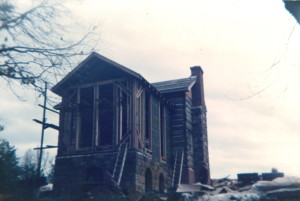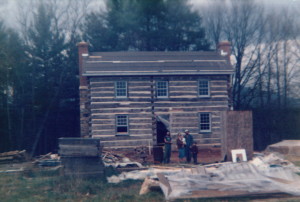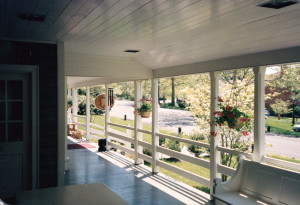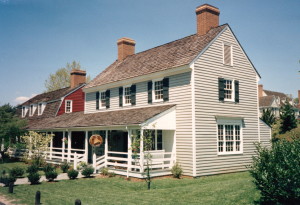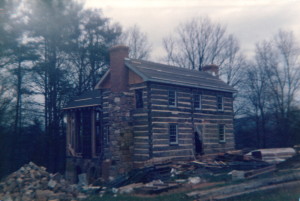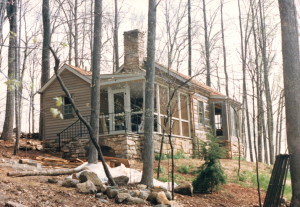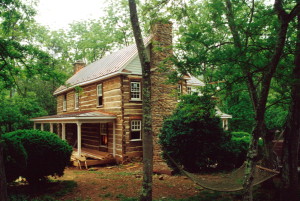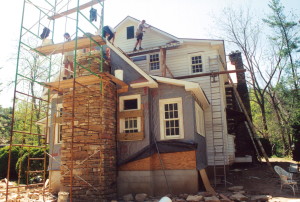On becoming a builder… part 3
By the time I started working at the Boar’s Head Inn I had already learned the skill and confidence needed to construct a home. I had personally undertaken all the various trades involved in building a home. I was a certified “jack of all trades”.
I had also salvaged many older structures for their materials. And, I had gained an eye for studying homes, seeking out what appealed to me, and questioning what was it about each of those structures that made them special. I had also taken engineering and business classed in college… so, even though I was unaware of it… I was on the path to becoming a designer/builder.
Here on this project, while working at this high-end “Old Virginia” resort, I learned what could be built today using modern materials and techniques, where cost was no object… in other words… quality ruled the day.
All I needed to complete my future niche in home building was to gain exposure to log and timber-frame construction. And, that is when fate stepped in.
You see, our summer lease on the apartment that we had rented in the city was coming to an end and so we sought out, and found, a rental home out in the surrounding countryside. It turned out that we moved into a house across the street from Charles McRaven… the most widely published author on log cabins, stone work, and blacksmithing.
Originally posted 2015-06-17 14:48:05.
On becoming a builder… part 2
This is the Boar’s Head Inn gift shop, which I helped build.
In 1985 my wife and I (along with a new baby) abandoned our “back-to-the-land phase” of our life and moved to the city of Charlottesville, Va. The primitive lifestyle we had found in the hills of Tennessee was too hard to maintain with the new addition that we had added to our family, and, we wanted to be closer to family.
We chose Charlottesville not only for it’s proximity to family and friends but because it was a prosperous college town with breathtaking views that are common in the surrounding counties.
We rolled into town with everything that we owned on the back of a Datsun pickup truck. It looked like a scene from the Beverly Hillbillies.
After subletting an apartment near the University for the summer I went looking for work. I was hired by the first firm that I talked too.
Originally posted 2015-06-17 13:57:58.
On becoming a builder
This was the first log cabin that I ever helped build.
The year was 1985… that’s over thirty years ago… wow… where do the years go?
I was just a carpenter at the time, working for another builder.
I didn’t design this home nor can I claim her as one of mine, but she holds a special place in my heart.
This house, it turned out, changed the course of my life.
This is the home where I realized that I wanted to build unique homes for a career. This was my calling. This was my purpose.
Prior to working on this home, as a fifteen year old teenager, I had helped my dad build his dream home. I went on while in my early 20’s to build two homes for myself. I learned the skill and practice of salvaging materials from old structures, and on occasion, I also worked for several contractors… to pay the bills.
I worked hard during that phase of my life and learned a lot, but life was something for me to just enjoy at that time, and I had little focus. It seemed that every time I finished a project I thought that that was likely my last build… that I would then go on to getting a real job in corporate America.
It didn’t work out that way.
I had become addicted to building.
Originally posted 2015-06-17 13:21:41.
A screen porch… part 3
I really like the blend of painted siding, of stone, and of antique log, that make up this outdoor room.
One of the wonderful things about having a screened porch on a log cabin is that when you are sitting on the porch you find that the cabin is pulling you to come in and explore… and when you are in the cabin… well, the porch is calling for you to come out and enjoy the great outdoors.
Originally posted 2015-06-15 13:27:51.
A screen porch
This little screened porch speaks volumes with regard to the argument of quality vs size. The painted wood is all redwood, the screening is bronze, the floor is flagstone, the furnishings didn’t come from a big box store. Which would you rather have… this porch, or one twice as large made of cheaper materials and furnishings?
I don’t think the answer to that question is a “right or wrong” situation but what confuses me is that the reality is that 99.99% of people choose the larger, cheaper option when building a home. Almost no one chooses the “intense quality option”… Why is that?
Originally posted 2015-06-15 13:05:34.
Log cabin restoration… part 19
I admit it, I did “refine” this old cabin a bit.
I felt she deserved it… like jewelry on a woman… the returns on just a small touch or two are exponential.
She now has a copper roof with ornate returns at each corner. We put a hip roof on her porch which really makes her front profile snap. And we applied painted siding to the cabin’s gable ends to help her blend with her addition and give a cleaner look to the logs.
I think the original builders of the cabin would be proud to see their work looking this good 175 years later. I wonder how many builders today will be able to say the same about their creations that far into the future?
Originally posted 2015-06-14 10:54:55.
Log cabin restoration… part 18
Here’s the back corner of this home.
I often judge a home’s design by how the most neglected viewing of the home appears to me.
Notice some of the details found back here… under the ladders you will see that the electric meter and gas supply have been enclosed in a nicely boxed attachment to the house… for a hundred dollars worth of labor and some scrap material left over from the job and these owners will never have to see those ugly utility features stuck on the side of their home.
Then there is the attic vent, created from an old window shutter found on site. Here we likely just saved that hundred dollars that it cost to build that meter base box and as a result we’ve got something more solid, more attractive, and we did the environment a favor by recycling.
Then there are the little returns on the corners of the roof. Just a small touch, but they really snazz a house up.
I had hoped to make this little addition out of stone… it would have been nice… and it wouldn’t have taken a lot of material… but the budget wasn’t there for it… there is always a budget that I struggle with it seems.
Originally posted 2015-06-14 10:31:00.

